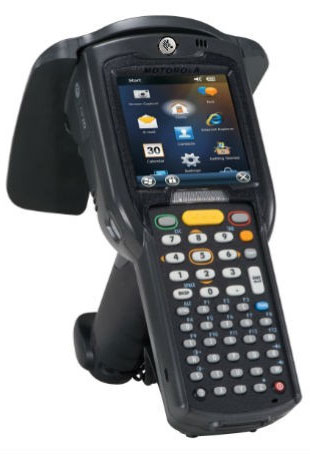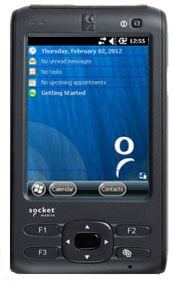RFID vs Barcodes
 With the introduction of NFC, RFID has become a trendy technology, but is it really a necessity for your business? Let’s go over some of the differences between barcodes and RFID:
With the introduction of NFC, RFID has become a trendy technology, but is it really a necessity for your business? Let’s go over some of the differences between barcodes and RFID:
- Line of Sight – Rather than using light to collect or read a number from a barcode, radio waves are used to read a number from the RFID tag. Therefore, RFID does not require a line of sight to operate, but rather you can wave the RFID reader to read the tags.
- Multiple Item Scanning – Since RFID does not require line of sight it is not necessary to present each tag to the reader separately (as is required for barcodes); instead, all tags within the range of the reader can be read almost simultaneously as they pass the reader.
- Automation & Accuracy – Barcodes require a person to manually read each individual barcode, which can lead to manual read errors and mis-scanning. RFID, on the other hand, is a fully automated solution with a higher accuracy rate.
Although there is a huge savings in RFID technology from a resource, time and accuracy standpoint, we rarely recommend a business migrating from a completely manual process to a RFID solution. Companies that currently incorporate barcodes face the best return on investment from a RFID solution. Talk to one of our experts today to get a full assessment of your business.
Socket Incorporates NFC in theirs SoMo 655
 Socket has announced that commencing in June, its SoMo 655 handheld computer will be able to read and process information using Near Field Communications (NFC) technology. NFC is an RFID technology enabling the wireless transfer of information at short range with extremely simple setup.
Socket has announced that commencing in June, its SoMo 655 handheld computer will be able to read and process information using Near Field Communications (NFC) technology. NFC is an RFID technology enabling the wireless transfer of information at short range with extremely simple setup.
The SoMo 655 RFID Reader with NFC operates both as a reader and writer. The SoMo 655 will read NFC High Frequency 13.56MHz contactless smart tags including those that are ISO/IEC 14443A and B compliant including Mifare and Sony FeliCa. It will also read tags that are ISO 15693 compliant, EPC GEN 2 HF and ISO 18000-3 mode 3 compliant, and will read many other proprietary tags. The RFID NFC reader plugs into the SoMo 655 handheld computer and enables single handed operations. The model 6E2 RFID reader has a U.S. Manufacturer’s Suggested Retail Price (MSRP) of $225.00. The model 6P2 is a combination RFID NFC reader and barcode scanner with a U.S. MSRP of $569.00. The RFID Readers will be in black and antimicrobial white to match the SoMo 655 and 655Rx, respectively.
Will RFID Lead to Near-field Communications (NFC)?
![rfid-tag[1]](https://www.barcodesinc.com/news/wp-content/uploads/2009/06/rfid-tag1.jpg) Mobile banking and payments is considered a promising area, in which near-field communications (NFC) is widely viewed as the pinnacle. NFC promises to turn the mobile phone into a secure credit card by enabling the exchange of data between devices over about four inches of distance. While companies work out the kinks to make it attractive for all members of the ecosystem, including carriers, radio frequency identification (RFID) tags that can be affixed to the mobile phone are cropping up as a temporary solution – one that Aite Group senior analyst Nick Holland says is extremely flawed.
Mobile banking and payments is considered a promising area, in which near-field communications (NFC) is widely viewed as the pinnacle. NFC promises to turn the mobile phone into a secure credit card by enabling the exchange of data between devices over about four inches of distance. While companies work out the kinks to make it attractive for all members of the ecosystem, including carriers, radio frequency identification (RFID) tags that can be affixed to the mobile phone are cropping up as a temporary solution – one that Aite Group senior analyst Nick Holland says is extremely flawed.
“This is seen by the people who put the stickers out as some interim technology that will magically get us to NFC, whereas what is really required is a solid business case for NFC and a level of merchant penetration for contactless payments that makes NFC viable,” Holland said. “This, as far as I’m concerned, is a step in the wrong direction. This is not something that will accelerate NFC. If anything, it’s going to be a distraction.”
Companies including Blaze Mobile, MasterCard, First Data and, as of today, Alcatel-Lucent and Tetherball, are among those using RFID stickers to bridge the gap to NFC. Alcatel-Lucent (NYSE: ALU) announced today its touchatag venture will work with Belgacom mobile and micro payments company PingPing, to create an open model of application development for contactless cards and mobile payments. Through the partnership, Belgian consumers can use one contactless card or sticker to launch mobile payments or other mobile applications.
Use of Near Field Communication Growing
![phpAt1Dtp[1]](https://www.barcodesinc.com/news/wp-content/uploads/2009/05/phpAt1Dtp1.jpg) Near Field Communication (NFC) is a short-range, high-frequency (13.56 MHz) wireless technology that allows for the exchange of data between two NFC-enabled devices, such as mobile phones, over a distance of a few centimeters. Among the applications enabled by NFC are contactless transactions for payment and transit ticketing, simple data transfers and access to online content. It’s one of the fastest-growing wireless technologies, and now a number of vendors are launching products that extend its capabilities.
Near Field Communication (NFC) is a short-range, high-frequency (13.56 MHz) wireless technology that allows for the exchange of data between two NFC-enabled devices, such as mobile phones, over a distance of a few centimeters. Among the applications enabled by NFC are contactless transactions for payment and transit ticketing, simple data transfers and access to online content. It’s one of the fastest-growing wireless technologies, and now a number of vendors are launching products that extend its capabilities.
In addition to mobile phones, a variety of devices and machines can be NFC-enabled, according to the NFC Forum, a Wakefield, Mass., organization formed in 2004 to advance the use of NFC technology, ensure interoperability among devices and services, and educate the market regarding NFC. These include cash registers or other point-of-sale (POS) equipment, vending machines, turnstiles, parking meters, ATMs and PCs. The technology can also be used with posters, street signs and other public points of interest, certificates, food packaging and other items.
The use of NFC technology is growing, says Peter Preuss, the NFC Forum’s marketing chair and a senior manager at Nokia. NFC devices are being used in more than 65 projects worldwide, he explains, enabling users to make payments and access bus gates. A 2008 study conducted by ABI Research found that more than 419 million NFC chipsets will be shipped by 2012, and that NFC chipset shipments and revenue will continue growing steadily over the next five years, as the market adapts to the new technology.
(Original article: http://www.rfidjournal.com/article/purchase/4784)




